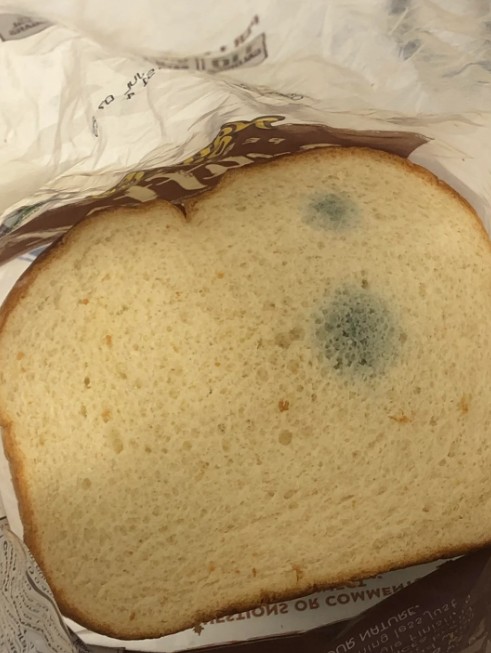Sincerely, I’ve been in that situation before: a hard, crusty loaf of bread on my counter and the question, “Is this just stale bread, or is it time to let go?” I can’t be the only one, either! In a single day, bread can go from being soft and fresh to being extremely hard. The real query, though, is: is it safe to consume stale bread? How about those greenish-blue patches that appear as though they were unexpected guests at a party you never hosted?
Let’s examine this because, while stale bread can occasionally be saved, it’s useful to know the difference between “past its prime” and “just plain unsafe.”
Is it safe to consume stale bread?
First, the good news: if the bread is dry and not moldy, stale bread is generally safe to consume. When bread loses moisture, it becomes stale. As a result, even though the bread is chewy or hard, it is still perfectly fine.
The natural process of retrogradation, in which the starch molecules in the bread re-crystallize and release water, is what causes the texture change. This isn’t harmful; it’s just gross to eat on its own, especially if you were hoping for the soft texture of freshly baked goods! Don’t discard it, though!
There are several methods to revive stale bread:
Warm it up: Wrapped in foil, place it in the oven for a few minutes at 350°F, or about 175°C, to rehydrate the bread’s interior.
Toast it: Because stale bread crisps so beautifully, it actually makes excellent toast. Repurpose it: We’ll talk more about that in a moment, but stale bread can be a culinary treasure trove.
Now, you may be disappointed if you were hoping to eat stale bread just like that, maybe with a little jam or butter. However, there is still life in that loaf if you are willing.
If you’re not going to eat stale bread plain, what can you do with it?
Stale bread is an ingredient, not trash. In fact, some recipes specifically call for stale bread because fresh bread would likely make them worse.
Here are some fantastic uses for stale bread:
Breadcrumbs Pulse your stale bread in a food processor to further dry it out, then store it in an airtight container. Excellent for adding bulk to meatballs, breading any protein, or topping casseroles.
To make the croutons, cut the stale bread into cubes, drizzle it with olive oil, season it, and bake it. Ideal for soups and salads.
French toast: In actuality, stale bread performs better and exhibits greater durability than fresh bread. Instead of crumbling and becoming mushy, stale bread will absorb the custard mixture.
Bread Pudding: This always works best with stale or slightly old bread. The recipe dough is made directly with old bread.
Panzanella: This Italian salad requires stale bread, which gave it a chewy texture when combined with juicy tomatoes and olive oil.
Stuffing: Stale or slightly old bread always works well for stuffing, whether you like it or not.
So the next time you have stale bread and recipes written down, use that stale bread to make something.
Moldy bread, what about it?
At this point, a sudden change takes place. You should never eat moldy bread. You shouldn’t simply remove the moldy portion of anything you’re thinking about eating, even if you only notice it on a tiny piece. It might not work with bread, but some people might get away with it with hard cheeses or especially dense vegetables. Why? since bread is porous. Mold spores are able to spread throughout the loaf, whether you can see it or not, thanks to the soft center of the bread.
Some people who are sensitive to mold may experience respiratory distress or allergic reactions after eating moldy bread. Certain molds have the ability to produce mycotoxins, which are poisonous substances linked to food poisoning and other illnesses.
Therefore, it is best to simply throw out your bread if it resembles the moldy loaf with the black or green spots in that picture. You cannot be overly cautious!
How Much Time Does Bread Need to Mold?
This is an excellent question, and the response is contingent upon several factors:
Moisture: Compared to drier, mass-produced bread, fresh, moist bread—like that from a bakery or your own kitchen—molds more quickly.
Conditions: Mold grows best in warm, humid environments. Things will move more slowly if it’s cooler and less humid.
Preservatives: To prevent the growth of mold and extend its shelf life, store-bought bread frequently contains preservatives like calcium propionate. In every situation:
Two to three days at room temperature for fresh bread free of preservatives
Loaf bread from the store that contains preservatives: It keeps for at least a week when stored in a clean plastic bag.
Bread that is refrigerated may prevent mold growth for seven to ten days, but it may also go bad more quickly.
How to Prevent Molding or Staling in Bread
To keep bread from molding and staling too soon, a delicate balancing act is required.
What are you able to do then?
Short-term storage at room temperature: Place the bread in a paper bag or bread box if you intend to consume it within a few days. Avoid plastic whenever you can; only use it if you’re in a hurry. Plastic retains moisture, even in bags that are only stored for a short time, which can hasten the growth of mold.
Freeze (long term): Freezing prevents both staling and the growth of mold. To ensure that you only take out what you need, slice the bread first. To avoid freezer burn, use a freezer bag and wrap it in plastic or foil.
Stay away from the refrigerator (most of the time): Unexpectedly, bread stales more quickly when refrigerated. The cold causes the starch to retrograde more quickly. Refrigerate only if mold is a concern and your home is extremely hot or humid.
Use a cloth bag or bread box: These options slow down the rate of staling (between the refrigerator and plastic) and allow enough air to circulate to prevent mold.
How to Store Different Types of Bread
Here are some quick tips because not all bread is made equal.
Use a paper bag or bread box to store artisan bread, such as sourdough, at room temperature for two to three days (or longer if frozen).
Sandwich loaves can be stored for up to a week in their original plastic bag. After opening, place in the freezer or tightly reseal.
Homemade bread will stale or mold quickly, usually within two to three days, if it contains no preservatives. What you won’t eat, freeze.
The bottom line is that stale bread is safe and even better for some recipes. It is not harmful and is dry. Avoid eating bread that has mold on it, even if it appears to be just touched. Mold can spread, and you don’t want to put your health at risk.
You can save money, make meals for the family, and prolong the life of your bread by being a little proactive and taking quick action when necessary. Throwing away a perfectly good loaf or, worse, discovering it’s too late while toasting and staring at green fuzz is something no one enjoys.
Consider whether your bread is moldy or stale the next time it’s on the edge. One results in stuffing. The trash is located at the other end. Choose wisely!


